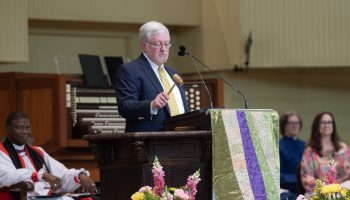
As an expert in international religious demography and associate director of research and senior demographer at the Pew Research Center, Conrad Hackett knows his data.
Among the reports Hackett has authored are “The Future of World Religions: Population Growth Projections, 2010-2050,” and when Pew releases reports on global population growth, particularly measuring religion in China, it’s Hackett breaking it down for the public.
At 2 p.m. today in the Hall of Philosophy, he’ll wrap up Week Four of the Interfaith Lecture Series exploring “World Religion and a Shifting Population,” sharing Pew’s work from the past few years and what it means with regards to the week’s theme.
In July 2022, as the world’s population was projected to hit 8 billion later that year, Hackett noted that half of all of those people live in just seven countries; China was still the most populous with 1.426 billion, but India was closing that gap with 1.417 billion.
China’s population, he wrote in 2022, was greater than the other five most populous countries combined. Another Pew report came in August 2023, detailing the challenges of measuring religion and religious trends in China — namely, those challenges were shortcomings in data; an “awkward fit” of categories that worked in other parts of the world, but not in China; and the impact culture and politics have on religious activity.
Even the word “religion” is literally foreign; Chinese scholars translated the word from Western texts as “zongjiao,” and many broadly-religious beliefs or practices don’t quite fit under that word’s umbrella.
“Based on formal religious identity, China is the least religious country in the world (among all places where survey data is available),” Hackett wrote in a short piece titled “Is China a religious country or not? It’s a tricky question to answer.” “Just one-in-ten Chinese adults self-identify with a religion, according to the 2018 Chinese General Social Survey (CGSS). China also has the largest count of people — about 1 billion adults — who claim no formal religious affiliation.”
Since such a small number of Chinese adults identified with a religion, it probably wasn’t surprising that only 3% said religion was “very important” in their lives.
But this was what could be surprising: “Among the total population, minority shares say they believe in religious figures and supernatural forces. But most Chinese people engage in practices premised on belief in unseen forces and spirits,” Hackett wrote. “Chinese people, in other words, are more religious in their practices than in their identities or beliefs.”
This is where the word “zongjiao” falls short. Many Chinese reported belief in more than one religious figure or force, and those beliefs are far more common than a formal religious identity.
“Broadly religious practices are common elements of life in China, and some are practiced by substantial shares of the population,” Hackett wrote. “For example, about a quarter of adults (26%) burn incense to worship deities at least a few times a year” as a request for blessings, and one of the most common customs in China is visiting the gravesites of family members — there are several days throughout the year, he added, specifically “designated for the veneration of ancestors.”
There’s also a strong sense among Chinese people of seeing the world as enchanted — almost half believe in the traditional practice and power of fengshui. So yes, based on the data for formal religion, for zongjiao, China isn’t a very religious country. If the ideology of the ruling Chinese Communist Party is considered, China’s actually an atheist nation.
“And yet,” Hackett wrote, “based on common behaviors, China is a country in which religion, broadly understood, continues to play a significant role in the lives of a large share of the population.”




